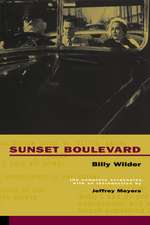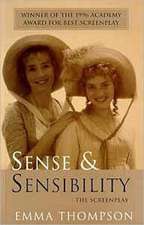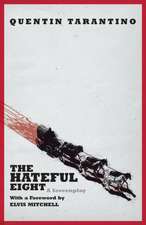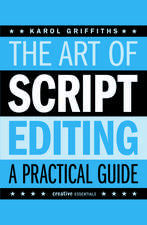The Film Novelist: Writing a Screenplay and Short Novel in 15 Weeks
Autor Dennis J. Packarden Limba Engleză Paperback – 9 noi 2011
The author has devised a fifteen week program starting from a one-sentence pitch to the novel itself, which includes filming a scene from your script/novel. He grounds the discussion of early film novels, likeThe Maltese Falcon, Of Mice and Men, andThe Misfits, to provide historical and theoretical background while detailing the practical, sequential approach for completing a short novel and script.
Preț: 206.81 lei
Nou
Puncte Express: 310
Preț estimativ în valută:
39.57€ • 41.43$ • 32.74£
39.57€ • 41.43$ • 32.74£
Carte tipărită la comandă
Livrare economică 07-21 aprilie
Preluare comenzi: 021 569.72.76
Specificații
ISBN-13: 9781441103178
ISBN-10: 1441103171
Pagini: 232
Ilustrații: 27
Dimensiuni: 138 x 216 x 15 mm
Greutate: 0.3 kg
Editura: Bloomsbury Publishing
Colecția Continuum
Locul publicării:New York, United States
ISBN-10: 1441103171
Pagini: 232
Ilustrații: 27
Dimensiuni: 138 x 216 x 15 mm
Greutate: 0.3 kg
Editura: Bloomsbury Publishing
Colecția Continuum
Locul publicării:New York, United States
Caracteristici
Allows
writers
to
expand
their
careers
by
increasing
the
potential
of
having
their
works
filmed.
Notă biografică
Dennis
J.
Packard
is
a
professor
at
Brigham
Young
University.
He
holds
a
PhD
in
Philosophy
(Stanford)
and
in
Theater
and
Film
(BYU).
Packard
has
produced
two
films
(Firecreek,
Hottieboombalottie),
and
is
currently
involved
with
two
in
pre-production.
Cuprins
Introduction
Stage One: Warming Up
Chapter l: Sentences-Week One
Chapter 2: Scenes-Week Two
Chapter 3: Subtext-Week Three
Stage Two: Summarizing
Chapter 4: Pitch-Week Four
Chapter 5: Synopsis-Week Five
Chapter 6: Scenario-Weeks Six and Seven
Stage Three: Expanding
Chapter 7: Script-Weeks Eight to Ten
Chapter 8: Novel-Weeks Eleven to Thirteen
Chapter 9: Film-Weeks Fourteen to Fifteen
Conclusion
Appendix
Suggested Readings
The Possibility of Film Novels
Acknowledgements
Bibliography
Endnotes
Stage One: Warming Up
Chapter l: Sentences-Week One
Chapter 2: Scenes-Week Two
Chapter 3: Subtext-Week Three
Stage Two: Summarizing
Chapter 4: Pitch-Week Four
Chapter 5: Synopsis-Week Five
Chapter 6: Scenario-Weeks Six and Seven
Stage Three: Expanding
Chapter 7: Script-Weeks Eight to Ten
Chapter 8: Novel-Weeks Eleven to Thirteen
Chapter 9: Film-Weeks Fourteen to Fifteen
Conclusion
Appendix
Suggested Readings
The Possibility of Film Novels
Acknowledgements
Bibliography
Endnotes
Recenzii
The
Film
Novelist
is
a
must
read
for
teachers,
students
and
anyone
else
who
loves
films
and
novels.
Packard
has
written
a
uniquely
informative,
surprisingly
deep
yet
practical
handbook
on
how
to
multi-task
the
creative
writing
process.
--
Jane
Kagon
is
an
international
media/education
consultant
and
Senior
Fellow
at
the
USC
Annenberg
School's
Center
for
the
Digital
Future,
former
Director
of
UCLA's
continuing
education
division
for
entertainment
professionals
Excerpts included in Gotham Writer's Workshop monthly e-newsletter for screenwriters. http://www.writingclasses.com/mailing.php?id=2419
Rather than Balkanizing, categorizing, and compartmentalizing among the various formats and media, Packard's book offers more of a synthesizing, rather than an analytical, orientation. Professor Richard Walter, UCLA Screenwriting Chairman
Clear, concise and instructive. If in trouble, go back to the basics. This book's clarifying points will help more than you may think. --Anne Perry, International bestselling historical fiction novelist
Packard has, miraculously enough, come up with something that is truly new-a practical, pragmatic guide in getting scripts and novels on the page that can be marketed to both communities-literature and film-at the same time, with a sale in one market enhancing and expanding the opportunities in the other.
Excerpts included in Gotham Writer's Workshop monthly e-newsletter for screenwriters. http://www.writingclasses.com/mailing.php?id=2419
Rather than Balkanizing, categorizing, and compartmentalizing among the various formats and media, Packard's book offers more of a synthesizing, rather than an analytical, orientation. Professor Richard Walter, UCLA Screenwriting Chairman
Clear, concise and instructive. If in trouble, go back to the basics. This book's clarifying points will help more than you may think. --Anne Perry, International bestselling historical fiction novelist
Packard has, miraculously enough, come up with something that is truly new-a practical, pragmatic guide in getting scripts and novels on the page that can be marketed to both communities-literature and film-at the same time, with a sale in one market enhancing and expanding the opportunities in the other.











